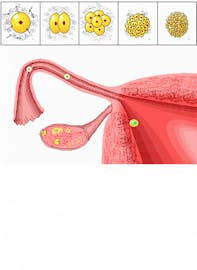Blastocyst

Fertilization normally occurs within the uterine tube. About twenty-four hours after the zygote is formed, it divides, giving rise to two daughter cells. These cells, in turn, divide to form four cells, these divide into eight cells, and so forth. With each division, the resulting cells are smaller and smaller. The distribution of the zygote's contents into smaller and smaller cells is called cleavage, and the cells produced in this way are called blastomeres. The mass of cells formed by cleavage is still enclosed in the original egg cell, and in about three days it consists of a solid ball called morula. The morula enters the uterine cavity and remains unattached for about three more days, at which time the morula develops a fluid-filled cavity. Once the cavity appears, the morula becomes a hollow ball of cells called a blastocyst. Within the blastocyst, cells in one region group together to form an inner cell mass that eventually becomes the embryo.



